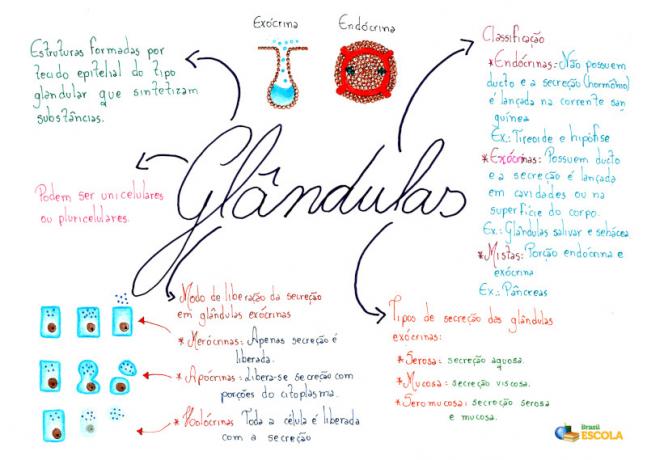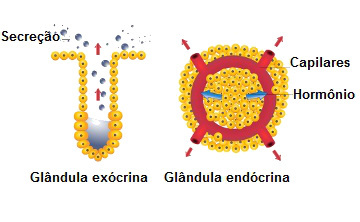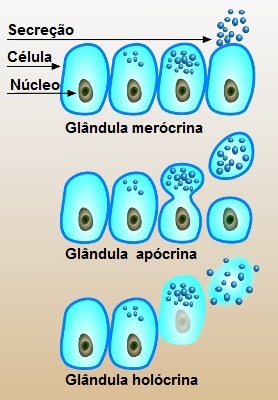Youepithelial tissuesthey stand out for their ability to secrete, in addition, of course, to their role in the lining of the body. The epithelium that has the secretory function is called gland and it is responsible for the production of essential substances for the functioning of the body.
A gland can be formed by a single isolated cell, called single cell, or present several cells grouped, being called multicellular. An example of a unicellular gland is the goblet cell, which has a shape similar to a chalice and is characterized by its ability to secrete mucus into the airways and tract. gastrointestinal.
Mind Map: Glands

* To download the mind map in PDF, Click here!
At multicellular glands they are found in the greatest quantity in the body and are formed from epithelia that proliferate and enter the connective tissue. According to how the release of secretion takes place, the glands are classified into endocrine and exocrine.

There are two main types of glands.
→ exocrine glands
The exocrine glands release the secretion on the free surface (body surface or organ light) and present channels or ducts through which the secretion passes until it reaches the place where it will be eliminated. In these glands it is possible to observe two distinct parts: a
secretory portion and the glandular ductss, which are connections with the epithelium that originated it.It is customary to classify the exocrine glands according to the morphology of the secretory portion. In this case, we have tubular, acinone, and compound exocrine glands. At tubular or tubular exocrine glands present the secretory portion in the form of a tube. already the acinar or alveolar exocrine gland presents the secretory part with a more rounded shape. Finally, we have the composites, which can be tubular, acinous or tubuloacinous. They have a secretory portion with characteristics of both the tubular and acinous glands.
The exocrine glands can be further classified according to how the secretion leaves the cell into: merocrine, apocrine and holocrine. In the merocrine glands, secretion is released without any loss of cytoplasm. At apocrine glands, in turn, eliminate secretion with portions of the cytoplasm. already the holocrine glands are those in which the entire cell is eliminated with secretion (See diagram below).

Observe the different ways to eliminate secretion *
Like example of exocrine glands, we can mention the mammary, sweat and sebaceous glands.
→ endocrine glands
The endocrine glands eliminate their secretion directly into the bloodstream and, unlike the exocrine glands, they do not have a glandular duct. The product of these glands is called hormone and the set of these glands form the endocrine system.
Based on the organization of their cells, we can classify the endocrine glands into cord and vesicular. In the cord type, the gland cells are arranged in rows that bifurcate and fuse randomly. In the vesicular type, the cells form vesicles filled with secretion.
Like example of endocrine glands, we have the thyroid, the pituitary, the parathyroid, the adrenal, among others.
Curiosity: The pancreas is a gland that acts as endocrine (pancreatic islets) and exocrine (pancreatic acini), which is called a mixed gland.
*Image credit: Wikimedia Commons
By Ma. Vanessa dos Santos

